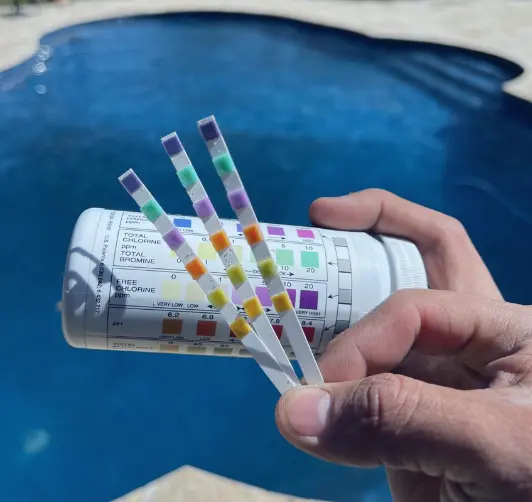
Hey there, fellow Long Island pool owner! With warmer weather on the horizon, it’s time to consider opening your pool for the upcoming swimming season.
We know how important it is to properly open your pool to ensure a safe, clean, and enjoyable swimming experience for your family and friends.
That’s why we’ve compiled this comprehensive guide specifically tailored to Long Island pool owners like you.

This article will describe the entire pool opening process, highlighting the importance of getting it done the right way.
While it’s true that you could try to tackle the pool opening yourself, there are numerous benefits to having a professional handle the job.
Trust us; after doing thousands of pool openings for our clients, we can confidently say we’ve seen it all.
Before diving into the pool opening guide, let’s talk about some common questions you may have before opening your pool.
First, you might be wondering the best time to open your pool.
(Hint: The earlier, the better).

The best time to open the pool varies depending on the specific weather patterns each year, but generally, it’s a good idea to open your pool in April or early May. For a more in-depth answer, check out our post on when to open your pool.

The next question that comes to your mind while considering opening your pool is its cost. Well, it can depend on various factors like the size of your pool, the different features of your pool, the equipment status, and the amount of work required.
On average, you can expect to pay between $300 to $600 for a professional pool opening service.
Remember that getting your pool opened professionally will save you time, effort, and potentially costly mistakes.

You might also be curious about how long it takes to open a pool. If you are thinking of doing it yourself, it could take anywhere from 2-3 days to an entire weekend, depending on your experience and the condition of your pool.
If you hire a professional pool services company like Romanelli & Son Pool Service, the process is typically quicker and more efficient, with most pool openings completed within 1-2 hours.
Before we get into the nitty-gritty, let’s start with some essential prep work to ensure a smooth pool-opening process.

First, gather all the necessary tools and equipment to get your pool up and running.
This includes a pool skimmer, vacuum, brush, water test kit, and any necessary tools for equipment maintenance.
Here’s a list of some essential tools needed for nearly every pool opening:
Having everything in one place will make the process much more manageable.
Pro Tip: Make sure your nearby planting beds are well-groomed, and keep an eye out for any tree branches that could drop leaves into the pool. A little garden maintenance and pruning can save you a whole lot of pool cleaning down the line.
Next, remove any standing water from the pool cover using a pool cover pump. Cleaning the cover before removal will prevent unwanted debris from falling into the pool.
Use a soft push broom or leaf net to remove leaves from the cover.
Hint: If the debris on the cover is dry, you can use a leaf blower to help quickly blow everything off.

Before diving into the pool opening process, taking inventory of your pool chemicals is a good idea. Please list the needed supplies and visit a pool supplies store nearby to purchase them. You can even order pool chemicals from us (and save the hassle of taking a trip to the store) at a discounted rate.
Make sure you have enough supplies to last the entire season.
Safety First: Please wear all the safety gear before handling pool chemicals. Every year, during the swimming season, many pool owners end up in hospital emergency rooms due to poisoning from pool chemicals. Also, store those chemicals safely, far from the reach of curious kids and pets. A cool, dry place works best, and always keep them in their original packaging with containers securely closed.

Safety First: Before turning on any electric components, double-check that everything is properly connected and there are no signs of damage. Once you’re confident that all is well, turn on the equipment.


Tip: Store the cover in the garage or indoors. A cover left outside WILL be damaged.


Finally, reconnect the electricity for your heat pump and other electrically powered equipment in your pool setup. Double-check that everything is connected correctly and functioning safely before diving into your freshly opened pool.
Congratulations! You’ve successfully opened your pool for the season by following these steps.
But before diving in, we must check the water chemistry and other things. Let’s get straight into it.

Start by testing your pool water using a reliable test kit or test strips. Check the chlorine levels, pH, alkalinity, and calcium hardness, and note any imbalances. While you’re at it, observe the water’s clarity. Clear water is a good indicator of proper water balance and filtration.
Here are the ideal levels for perfect water chemistry:
Total Alkalinity: 80 to 150 ppm
pH: 7.2 to 7.6
Total Hardness: 175-270 ppm
Pro Tip: Balanced water chemistry is essential to keep your pool in top shape. Make it a habit to check your water at least once a week and adjust as needed to keep everything running smoothly. Alternatively, you can also opt for one of our weekly pool maintenance plans to make it a breeze.


Safety Tip: When it comes to handling chlorine shock, safety first! Always wear gloves and safety gear while adding it to your pool. And remember, mixing different types of shock in the same bucket can be a big no-no as it could even cause an explosion.
Pro tip: Be sure to spray down your pool deck with a hose to rinse away any stray chemicals. This will keep the swimmers’ feet safe from any potential hazard.
With your pool’s basic chemistry in balance, it’s time to tackle any specific water issues that might have emerged. This could include algae growth, high metal content, or other water chemistry concerns.
For algae, use an algaecide or specialized algae treatment to eliminate the growth and prevent it from returning. If your pool has high metal content, consider using a metal sequestrant to keep the metals in solution and prevent staining or discolouration.
If you are opening the pool yourself, you might miss addressing some water chemistry concerns. We recommend hiring a pool service like ours for appropriate water chemistry and treatment.

If you discover any damaged equipment during your inspection, it’s important to repair or replace it as soon as possible. Operating damaged equipment could lead to more significant issues or potential hazards for swimmers.
If you are getting your pool opened by Romanelli & Son Pool Service, we will address and fix any equipment-related issues during the pool opening appointment if it requires 20 minutes or less. If fixing requires more than 20 minutes, we’ll schedule a separate appointment to repair/replace the broken pool equipment.
Lastly, ensure your pool fencing, gates, and alarms function correctly. This is crucial in preventing unauthorized access to your pool, especially for young children or pets. Ensure gates latch securely, alarms function, and fencing is free from damage or gaps.
Following these pool equipment inspection and safety check steps ensures you are set up for a safe, enjoyable, and worry-free swimming season.
Cheers to a fantastic summer by the pool, fellow Long Islanders!

Congratulations! You’ve completed all the essential steps to open your pool for the season.
You can be confident that your pool is safe, clean, and ready for endless fun under the sun. Now, it’s time to reap the rewards of your labour and dive into that sparkling water!

Go ahead and invite your friends and family over for a refreshing swim or a laid-back poolside barbecue. After all, you certainly deserve it
Remember to keep up with routine maintenance throughout the season so your pool remains safe and enjoyable for everyone. But for now, it’s time to grab your favorite swimsuit, slather on some sunscreen, and make a splash in your paradise.
Long Island pool owners, we know you take pride in your pool, and you might even be tempted to tackle the pool opening process independently. However, it’s important to weigh the pros and cons of doing it yourself versus hiring a professional pool service company like ours.
Let’s dive into the differences.
While going the DIY route might seem appealing, there are some potential downsides to consider:
Time-consuming: You might have realized by reading our extensive pool opening guide that the process involves several steps. Doing it yourself can eat up a significant chunk of your precious time. A professional company like ours can do the job more efficiently, giving you more time to enjoy your pool.

Lack of expertise: Without experience in pool maintenance, it’s easy to make mistakes that could lead to costly repairs down the line. A professional pool service company has the knowledge to identify and address potential issues before they become major problems.
Safety concerns: Handling pool chemicals and equipment without proper training can be hazardous. A professional knows how to handle these materials safely and responsibly.
When you entrust your pool opening to a professional company like Romanelli & Son Pool Service, you get much more than convenience. Here are some of the key benefits:
Saving time and effort: A professional company like ours handles all the heavy lifting, allowing you to enjoy your pool instead of handling chemicals and equipment.
Precision and expertise: We have the experience and knowledge to handle every aspect of pool opening with precision.
We can spot potential problems quickly and fix them before they become costly, ensuring your pool remains in top shape all season long.
Peace of mind: Hiring a professional pool service company means you can relax, knowing that your pool is in expert hands. No more second-guessing yourself or worrying about whether you’ve done everything correctly – the pros have got you covered.
Long-term savings: You can avoid costly mistakes and potential damage from DIY pool opening. This means fewer headaches and more savings in the long run.
Tailored service: We can offer customized services to meet your specific needs and preferences to ensure your pool is maintained exactly how you want it.
Opening your pool by yourself might seem like a cost-saving measure, but the potential drawbacks and risks far outweigh the benefits. By hiring a professional pool services company like Romanelli & Son Pool Service, you’re investing in your pool’s longevity, safety, and overall enjoyment of your swimming experience.
Treat yourself to a hassle-free pool opening and a fun summer by booking your pool opening appointment by clicking the button below. Remember, it’s always better to open your pool earlier than anticipated because of potential unforeseen issues that might arise, such as equipment failure/repair.

As a Long Island pool owner, you might have questions about opening your pool for the season. Let’s address some of the most common ones:
Q: How long should I run the filter after opening the pool?
A: It’s generally recommended to run the filter continuously for at least 24 hours after opening your pool. This helps circulate the water and any added chemicals, ensuring proper balance and clarity.
Q: What chemicals do you need to open a pool?
A: To open a pool, you’ll typically need chlorine, pH increasers or reducers, alkalinity increasers, calcium hardness increasers, and shock treatment. Always test your water first and follow recommended guidelines.
Q: How do I clean the filter on a pool?
A: The cleaning methods depend on your pool’s filter type (cartridge, sand, or DE.) Each type requires a specific cleaning process, so it’s better to consult a pool service company like ours for guidance.
Q: How much chlorine to add to the pool when opening?
A: The amount of chlorine needed depends on your pool’s size and the water’s current chlorine level. You’ll want to test the water and follow the manufacturer’s guidelines for the appropriate dosage.
Q: How to shock a pool when opening?
A: To shock your pool, dissolve the shock treatment in a bucket of water and add it to the pool. Make sure to run the filter continuously while shocking. Also, follow the manufacturer’s instructions for appropriate dosage based on your pool’s size and water chemistry.
Q: What can I do if the pool water bubbles when turning on the pump?
A: If you notice water bubbling when turning on the pump, it could indicate air in the system. Check for loose fittings, leaks, or blockages and ensure sufficient water level. If the problem persists, consult a professional pool service company.
A well-executed pool opening sets the stage for a fantastic swimming season. Following the proper steps and promptly addressing any issues, you can enjoy crystal-clear water and healthy swim sessions in your backyard.
We hope this article has given you a clear overview of the pool opening process.
While a DIY pool opening might seem tempting, the drawbacks and potential risks make hiring a professional company like Romanelli & Son Pool Service a smart choice. By entrusting your pool opening to experts like us, you can save time and effort and enjoy peace of mind.
With Romanelli & Son Pool Service, you can dive into a summer of fun, relaxation, and cherished memories with family and friends.

We make pool ownership easy with stress-free maintenance, expert repairs, and cutting-edge tech. From sparkling water to pool automation, we handle every detail so you can relax and enjoy your pool.
© 2025 Paul Romanelli & Son Pool Service.